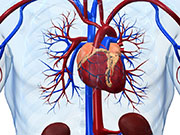Bleeding associated with increased rate of death, similar to that seen with myocardial infarction
MONDAY, April 13, 2015 (HealthDay News) — For patients undergoing percutaneous coronary intervention (PCI), spontaneous bleeding is associated with increased risk of death, comparable to that associated with myocardial infarction (MI), according to a study published in the April 14 issue of the Journal of the American College of Cardiology.
Dhruv S. Kazi, M.D., from the San Francisco General Hospital, and colleagues examined data for 32,906 patients who had a PCI and survived the index hospitalization. The authors assessed the correlations between spontaneous bleeding and MI after PCI and all-cause mortality.
The researchers found that between seven and 365 days after discharge, 530 of the patients had bleeds and 991 had MIs. Over a mean follow-up of 4.42 years, there were 4,048 deaths. The crude annual death rate was elevated after patients experienced a spontaneous bleed or MI compared with patients who experienced neither event (9.5 and 7.6 percent, respectively, versus 2.6 percent). There was an increased rate of death in association with bleeding (adjusted hazard ratio, 1.61) which was comparable to that seen with MI (adjusted hazard ratio, 1.91). After additional adjustment for longitudinal use of antiplatelet agents, the association of bleeding with death remained significant.
“This trade-off between efficacy and safety bolsters the argument for personalizing antiplatelet therapy after PCI on the basis of the patient’s long-term risk of both thrombotic and bleeding events,” the authors write.
One author disclosed financial ties to Genentech.
Full Text (subscription or payment may be required)
Editorial (subscription or payment may be required)
Copyright © 2015 HealthDay. All rights reserved.








